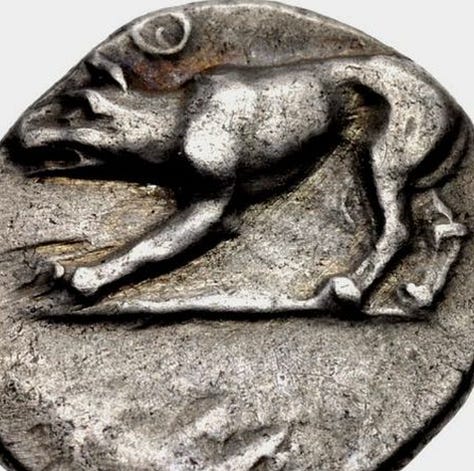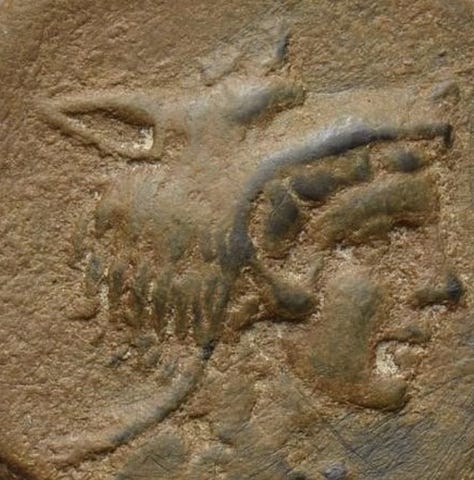Fresh Batch #145: The Wolf People, Tanit, Tanistry & Salic Lands
The Origins of Apollo
The premise of my work is to demonstrate the ancient empire of Europe, whose epicenter was Italy, was erroneously described as Roman by modern historians, but it was actually Etrusco-Phoenician, or in other words, Celtic. I have the benefit of descending from an Etruscan family that participated in the Roman Empire, and they were Celtic/Germanic in appearance. The location of Rome was irrigated to make it a suitable site for a city and was quasi-Etruscan right up until the time defined as the Common Era. This throws another proverbial wrench into chronology, but suffice to say, the very word Phoenician is from an Etruscan perspective, not an Oriental one, the word being Puni, which usually indicates things of a Purple nature, the Latin counterpart of which is Pœni. This became the Latin word for the Phoenicians, or the Purple Ones, the Irish version of which is Feni on account of the P to F interchange, i.e., pisc (Latin) and fish (English) being philologically identical.
The Phoenician language is referred to as Punic, but this is not specific to its origin. Punic is specifically from Sicily, or in other words, it is Sicilian Phoenician, or Italian Phoenician. Sicily was peopled by Etruscans. Two of its three languages are not Indo-European, meaning they are not similar to anything from the Orient, including Greek. The languages of Ancient Italy are alien to the rest of the world and the remaining inscriptions cannot be translated because of this. The only thing that can be figured out thus far is the gist of an inscription based on the words that Latin inherited from them. Latin is a lingua franca developed by the Italians; it is not descended from Greek. There is lore that Sicily was connected to the mainland before its isthmus was destroyed by an earthquake.
The alleged origins of Europeans coming from the Orient causes confusion because people associate Celts and Gauls with northern European cultures, from Britain to Scandinavia, yet their systems of language and alphabets, along with religious symbolism, masonry, navigation, and priestcraft originate in Italy. When I say Italy, it is to help the reader conceptualize the geographic region I reference; the present nation of Italy is a modern construct that wasn’t formed till 1861 AD by the Savoy family. According to Wiki, the House of Savoy allegedly descends from Humbert I, Count of Sabaudia (Umberto I “Biancamano”; 1003–1047 or 1048). The interchange of P and B is seen in Sabau and Savoy, but some claim that the name comes from sappo, a fir tree, and sapaudia, a fir forrest, which also shows the interchangeability between the P, B, and V. Recall that the B serves as a V in the Umbrian and Oscan languages.
It is not out of the realm of possibility that Sabaudia, or Savoy, is from the Sabines, but the Samnites were allegedly called Safineis by the Oscans, and Safine is philologically Sabine, which may connect them to the Samnites.
One of the tribes of the Samnites were called the Hirpini, or the Wolf People, which could also be People of the Wolf, which I suspect is the Etruscan Aplu, or Aita (Suri). This archetype is their winter solar deity, when they reckoned the year. It is the same as Lycean Apollo. I maintain that Apollo is from Aplu and the Etruscans did not borrow it from the Greeks. Apollon, spelled Apollyon in the Bible, is Abbadon, which means Father-Lord (Abba-Don), or Father-Most High (Ap-Elyon). But given that the Latin word for wolf is lupus, the root of which is lu, I suspect Aplu means Father-Wolf, or Wolf-Father, the sun in winter, and Lycean Apollo is borrowed from Italy; it didn’t originate in Greece. The Greek word for wolf is lykos, which is why they can’t use Aplu in the same context and need to signify Apollo with the word Lycean or Lyceus, a Latinization of Ἀπόλλων Λύκειος (Apollon Lykeios). On the third Greek coin, you’ll see the letters ARCH, which looks like ΑΡΧ in Greek. Arche means head. The coin is claimed to signify the Macedonian king Archelaos, which looks like Ἀρχέλαος. If you remove the Greek termination -ος, then it is Archela, which is similar to Hercle (the Etruscan way of writing Hercules) without its aspirate, which would be Ercle or Erchle, as well as Achle, the Etruscan way of writing Achilles.



But on the following coin, an Archelaus Didrachm (413-399 BC), it is admittedly the head of Apollo. The lambda (the Greek letter L) is not visible, but on other similar coins it is, yet in a much different strike.
The following coin looks like it is newer, or was not circulated as much, but the artistry is not as good. It may be forgery or it may not be. I don’t know. The point I would like to make is that Arche (Head) is separate from Lao. If my suspicion of Lu signifying Wolf in Aplu is correct, then here we have in the inscription Arche Lao, which would signify Head Wolf, or Wise Wolf, because lao and lu are philologically identical. For those new here, I understand Archelaos could literally mean Head of the People or Leader of the People, as well as Wisdom of the People. But there is no sigma (S) on the coin, is there? So I explore other possibilities, and that’s all this is at present.
It is assumed the letter O was cut off in the following strike, but if not, it’d be Arche La. The reason I’ve taken time to flush this idea out is that if my suspicions or inquiries have merit, then it indicates that Archelaos may be astrotheological and not historical, or if the man was historical, his name and story may have been infused with astrotheology through Greek mythological imperialism.
The following is an interpretation of the ancient boundaries of Italy, with Samnium in the middle and its southern portion occupied by the Hirpini.
According to Wiki, the Hirpini (Wolf People) inhabited the southern portion of Samnium, in the more extensive sense of that name, roughly the area now known as Irpinia from their name—a mountainous region bordering on Basilicata towards the south, on Apulia to the east, and on Campania towards the west. No marked natural boundary separated them from these neighboring nations, but they occupied the lofty masses and groups of the central Apennines, while the plains on each side, and the lower ranges that bounded them, belonged to their more fortunate neighbors.
I suspect Apulia is named after Aplu, and signifies Country of the Wolf, or Land of the Wolf, not necessarily because there were wolves there (although it may have been given that it was mountainous), but because it was named after this archetype.
I happen to be descended from a woman from Apulia, Lucera to be specific, and she had blue eyes. Lucera means Holy Wood in Etruscan (allegedly). This is yet another way of demonstrating that the Etruscans were Celtic, not Oriental or sub-Saharan African. At some point there needs to be a concession that Phoenician, or Punic, is Etruscan, not only due to its alphabet but due to its very name. And given that Hebrew and Chaldean take their letters from Phoenician, it demonstrates the spread of this system eastward, not westward as previously thought.
The implications of this knowledge are immense. The father of history, Herodotus, and the father of scientific history, Thucydides, made no mention of Rome. They existed in the 5th century BC, so either their work is ignorant and not historical, or the location we know as Rome was not called Rome back then. I suspect the latter, and that the Etruscan Empire is being covered up because, once you learn how to read the ancient Italian languages, along with Hebrew and Greek, you’ll see that there is no mention of any of the Biblical characters or narratives in Etruscan writing, which exposes everything that the religious institutions and nobility derives their power and lineages from as nothing more than fantasy stories created in the Middle Ages, and prior to the 3rd century AD these stories were used by the mystery schools of Alexandria in a different context. No Greek writer mentioned Moses prior the the end of the 3rd century AD (c. 270). Everything was inverted at an institutional level by secret societies that pull the strings from beyond the public view. Even now, low-level people of these organizations are getting exposed for their deviant behavior. They control everything from the education systems, industries, the media, government, militaries, etc. Are there factions within all of these systems? Of course. But there is an underlying system of control beyond the view of those not in the organization.
I cited Polybius in The Real Universal Empire to give the reader insight on the limits of the known European civilized world around the end of the 3rd to the middle of the 2nd centuries BC. He wrote, “What lies between Tanais (north of the Black Sea) and Narbo (Narbonne, France) stretching northward, is unknown to us at this present [moment], unless after diligent inquiring, we learn something of it. They that speak or write any thing of these matters are to be thought to know nothing and to lay down fables.”
Tanais is the Irish word for Lord. There will be mind-blowing connections made on the other side that, if they are not anecdotal, may more properly organize the historical record. We will also cover how land and titles in Gaul were transferred after the decline of the Roman Empire.
Watch or listen to Inner Whirled Podcast—Episode 2: The Age of Taur-ers because the second portion of this article was only possible due to my previous work. I didn’t make these connections till after I published the above book.
Become a member to access the rest of this article.
Keep reading with a 7-day free trial
Subscribe to Ancient History, Mythology, & Epic Fantasy to keep reading this post and get 7 days of free access to the full post archives.












